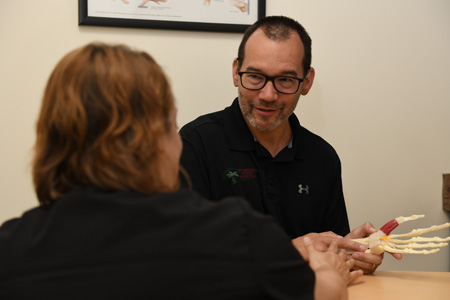Fractures of the Finger or Hand
![]() The hand is made up of 27 bones that form its supporting framework. This frame acts as a point of attachment for the muscles that make the wrist and fingers move. The alignment of the bones in your hand and fingers lets you perform many specialized functions, such as grasping a pen or manipulating small objects in your palm.
The hand is made up of 27 bones that form its supporting framework. This frame acts as a point of attachment for the muscles that make the wrist and fingers move. The alignment of the bones in your hand and fingers lets you perform many specialized functions, such as grasping a pen or manipulating small objects in your palm.
 A fracture occurs when enough force is applied to a bone to break it. Many people think that a fracture is different from a break, but they are actually the same. Fractures may be simple, with the bone pieces aligned and stable. Other fractures are unstable, and the bone fragments tend to displace or shift.
A fracture occurs when enough force is applied to a bone to break it. Many people think that a fracture is different from a break, but they are actually the same. Fractures may be simple, with the bone pieces aligned and stable. Other fractures are unstable, and the bone fragments tend to displace or shift.
If you think you fractured your finger, immediately contact your Celebration Orthopaedics hand surgeon and tell him exactly what happened and when it happened. Your doctor needs to determine not only which bone you fractured, but also how the bone broke. Bones can break in several ways. They can break straight across the bone, in a spiral, into several pieces, or shatter completely.
Symptoms
A fracture of the finger or hand may cause pain, stiffness, and loss of movement. Some fractures will cause an obvious deformity, such as a crooked finger, but many fractures do not. Because of the close relationship of bones to ligaments and tendons, the hand may be stiff and weak after the fracture heals. Fractures that injure joint surfaces may lead to early arthritis in those joints.
Signs and symptoms of a broken bone in the hand include:
- Swelling
- Tenderness
- Bruising
- Possible deformity
- Inability to move the finger
- Shortened finger
- Finger crosses over its neighbor when making a partial fist
- Depressed knuckle
Causes
Generally, a fractured finger or hand bone occurs as a result of an injury. They can result from a twisting injury, a fall, a crush injury, or direct contact in sports. You can cause a fracture when you slam your fingers in a door or put out your hands to break a fall. You can fracture a finger during a ball game if the ball jams your finger. Carelessness when working with power saws, drills, and other tools can result in fractures as well.
 Treatment Options
Treatment Options
Your Celebration Orthopaedics hand surgeon will put your broken bone back into place, usually without surgery. For finger fractures, you will get a splint or cast to hold your finger straight and protect it from further injury while it heals. Sometimes your doctor may splint the fingers next to the fractured one to provide additional support. Your doctor will tell you how long to wear the splint. Usually, a splint on a fractured finger is worn for about three weeks.
Most of the time, the bones of the hand can be realigned by manipulating them without surgery. A splint cast, or fracture brace, may be used to treat a hand fracture that is not displaced or to protect a fracture that has been set. The cast will probably extend from the fingertips down past the wrist almost to the elbow. Some displaced fractures may need to be set and then held in place with wires or pins without making an incision.
Depending on the type and severity of the fracture, you may need surgery to set the bone. Once the bone fragments are set, they are held together with pins, plates, or screws. Fractures that disrupt the joint surface usually need to be set more precisely to restore the joint surface as smoothly as possible. On occasion, the bone may be missing or be so severely crushed that it cannot be repaired. In such cases, a bone graft may be necessary.
Once the fracture has enough stability, motion exercises may be started to try to avoid stiffness. Your hand surgeon can determine when the fracture is sufficiently stable.
Recovery
The cast will be worn for three to six weeks. Gentle hand exercises can probably be started after three weeks. Afterward, the finger may be slightly shorter, but this should not affect the ability to use the hand and fingers. After the bone has healed, the surgeon may remove the implants or may leave them in place.
Begin using your hand again as soon as your doctor determines it is okay to move your hand or fingers. Joint stiffness may be experienced due to the long immobilization period. Doing simple rehabilitation exercises each day will help reduce the stiffness and swelling, restore strength, and improve range of motion. You may be prescribed to work with our occupational therapists to assist you with these exercises.
Perfect alignment of the bones is not always necessary to get good function. A bony lump may appear at the fracture site as the bone heals and is known as a “fracture callus.” This is a normal healing process and the lump usually gets smaller over time.
